"Takashi Murakami: The 500 Arhats" will start on Saturday, October 31 2015. The exhibition marks the first large-scale Murakami exhibition in Japan in 14 years. In this blog, we will introduce the highlights of this exhibition.
Highlight #1
The Japan Premiere of Takashi Murakami's Epic, The 500 Arhats
Takashi Murakami, inspired by a series of dialogues with art historian Tsuji Nobuo for The Geijutsu Shincho art journal, and by paintings of the Five Hundred Arhats by Kano Kazunobu (1816-1863) and Nagasawa Rosetsu (1754-1799), enlisted over 200 students from Japanese art colleges to carry out the arduous task of completing, in a very short period of time, his 100-meter-long magnum opus painting.
The work consists of four sections bearing the names of the legendary Chinese guardians of the four celestial directions (blue dragon - east, white tiger - west, red bird - south, and black tortoise - north). Addressing themes of religion and art, human mortality and limitations, this new monumental work breaks new ground in Murakami' s creativity. His The 500 Arhats was unveiled overseas, making the forthcoming exhibition in Japan a 'homecoming.'
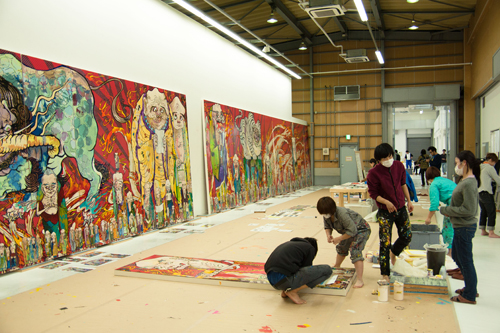
Production view, The 500 Arhats
Photo: Aminaka Kenta
* The 500 Arhats
The 500 arhats are thought of as enlightened disciples of Buddha who spread his teachings and give ordinary people salvation from worldly desires. The faith of the arhats was conveyed to Japan during the Heian period (8th-12th century) and flourished throughout the country from the Edo period (17th-19th century) on in the forms of paintings and sculptures. Kano Kazunobu's Five Hundred Arhat's (housed at Zojoji Temple in Shiba, Tokyo), a 100-scroll series of paintings, was exhibited in Japan in its entirety for the first time at the Edo Tokyo Museum immediately following the 2011 Great East Japan Earthquake and Tsunami, and at the Arthur M. Sackler Gallery, a Smithsonian museum in Washington, D.C. in 2012. Both exhibitions drew tremendous public attention.
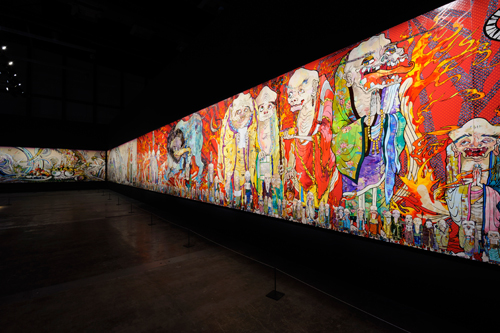
The 500 Arhats
2012 Acrylic on canvas mounted on board 302 × 10,000 cm Private collection
Installation view: "Murakami - Ego," Al Riwaq Exhibition Hall, Doha, 2012 Photo: GION
© 2012 Takashi Murakami/Kaikai Kiki Co., Ltd. All Rights Reserved.
Highlight #2
500 Arhats by Edo Artists, Nagasawa Rosetsu and Kano Kazunobu
Paintings by Nagasawa Rosetsu and Kano Kazunobu that greatly inspired Takashi Murakami's The 500 Arhats will be on view at the Mori Art Museum. Nagasawa Rosetsu's recently re-discovered microscopic painting depicts the 500 arhats and animal figures on a 3-centimeter square area. In contrast, Kano Kazunobu's Five Hundred Arhats is a voluminous series, consisting of 100 copiously painted scrolls produced over a period of 10 years. It depicts the training of the arhats and their acts of salvation. Kazunobu's dense colors and obsessive depictions overwhelm the viewers. Displaying the paintings of Nagasawa Rosetsu and Kano Kazunobu in conjunction with Takashi Murakami's The 500 Arhats allows a dialogue between the Edo artists and the artist of our time.
* Selections will be exhibited in rotation during the exhibition period.
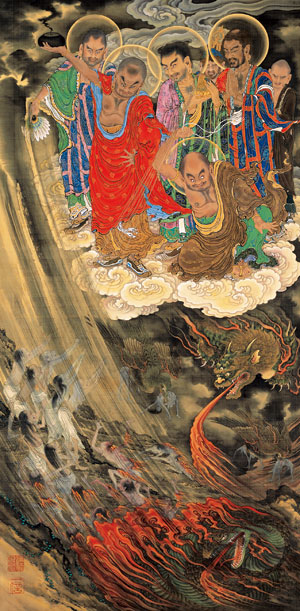
Kano Kazunobu
Scroll 22 ("The Six Realms: Hell"), Five Hundred Arhats
End of Edo period Ink and color on silk 172.3 × 85.3 cm
Collection: Zojoji Temple, Tokyo
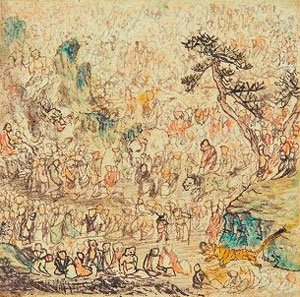
Nagasawa Rosetsu
Five Hundred Arhats
1798 Ink and light color on paper 3.1 × 3.1 cm
Private collection
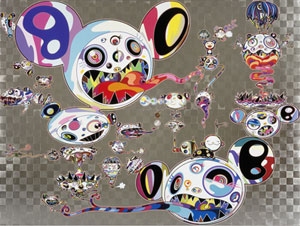
Hands Clasped 2015
Acrylic and platinum leaf on canvas mounted on aluminum frame 180 × 240 cm
©2015 Takashi Murakami/Kaikai Kiki Co., Ltd. All Rights Reserved.
Highlight #3
The "NOW" of Takashi Murakami through a Number of His Latest Works
The exhibition will also feature Murakami's large-scale sculptures such as The Birth Cry of a Universe, still in production after nearly 10 years, and Flame of Desire - Gold (2013); new paintings created especially for this exhibition from his signature series including "727" and "Tan Tan Bo"; as well as "Ensō" (circle) paintings and silver and gold "Karajishi" Chinese lion paintings, all of which will be shown for the first time in Japan. The exhibition presents the irresistable artistic world by Murakami, an extraordinary contemporary artist who keeps captivating the global art scene against the backdrop of Japanese culture.
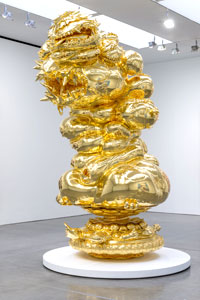
The Birth Cry of a Universe 2005-
Gold leaf on FRP, iron 451.3 × 268 × 302.8 cm
Courtesy: Gagosian Gallery, New York
©2005-2015 Takashi Murakami/Kaikai Kiki Co., Ltd. All Rights Reserved.
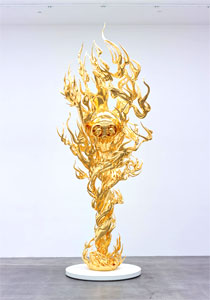
Flame of Desire - Gold 2013
Gold leaf on carbon fiber 498.4 × 188.6 × 183.1 cm
Courtesy: Blum & Poe, Los Angeles
©2013 Takashi Murakami/Kaikai Kiki Co., Ltd. All Rights Reserved.
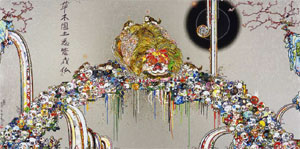
Lion Peering into Death's Abyss 2015
Acrylic and gold and platinum leaf on canvas mounted on aluminum frame 150 × 300 cm
©2015 Takashi Murakami/Kaikai Kiki Co., Ltd. All Rights Reserved.
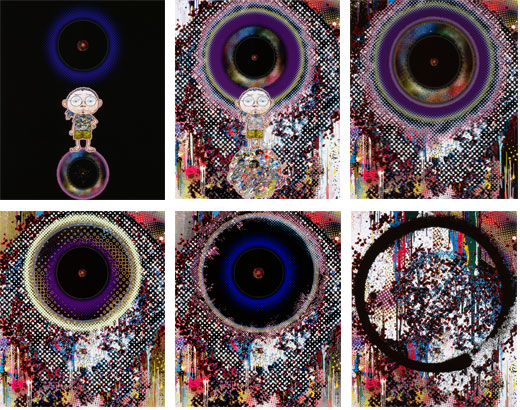
"Ensō" series 2015
Acrylic and gold and platinum leaf on canvas mounted on aluminum frame
170 × 144.7 cm (each)
©2015 Takashi Murakami/Kaikai Kiki Co., Ltd. All Rights Reserved.
■Relevant information
"Takashi Murakami: The 500 Arhats"
Saturday, October 31, 2015 - Sunday, March 6, 2016








